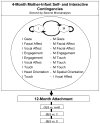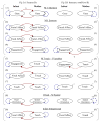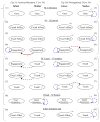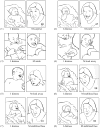The origins of 12-month attachment: a microanalysis of 4-month mother-infant interaction
- PMID: 20390524
- PMCID: PMC3763737
- DOI: 10.1080/14616730903338985
The origins of 12-month attachment: a microanalysis of 4-month mother-infant interaction
Abstract
A microanalysis of 4-month mother-infant face-to-face communication revealed a fine-grained specification of communication processes that predicted 12-month insecure attachment outcomes, particularly resistant and disorganized classifications. An urban community sample of 84 dyads were videotaped at 4 months during a face-to-face interaction, and at 12 months during the Ainsworth Strange Situation. Four-month mother and infant communication modalities of attention, affect, touch, and spatial orientation were coded from split-screen videotape on a 1 s time base; mother and infant facial-visual "engagement" variables were constructed. We used contingency measures (multi-level time-series modeling) to examine the dyadic temporal process over time, and specific rates of qualitative features of behavior to examine the content of behavior. Self-contingency (auto-correlation) measured the degree of stability/lability within an individual's own rhythms of behavior; interactive contingency (lagged cross-correlation) measured adjustments of the individual's behavior that were correlated with the partner's previous behavior. We documented that both self- and interactive contingency, as well as specific qualitative features, of mother and infant behavior were mechanisms of attachment formation by 4 months, distinguishing 12-month insecure, resistant, and disorganized attachment classifications from secure; avoidant were too few to test. All communication modalities made unique contributions. The separate analysis of different communication modalities identified intermodal discrepancies or conflict, both intrapersonal and interpersonal, that characterized insecure dyads. Contrary to dominant theories in the literature on face-to-face interaction, measures of maternal contingent coordination with infant yielded the fewest associations with 12-month attachment, whereas mother and infant self-contingency, and infant contingent coordination with mother, yielded comparable numbers of findings. Rather than the more usual hypothesis that more contingency is "better," we partially supported our hypothesis that 12-month insecurity is associated with both higher and lower 4-month self- and interactive contingency values than secure, as a function of mother vs. infant and communication modality. Thus, in the origins of attachment security, more contingency is not necessarily better. A remarkable degree of differentiation was identified in the 4-month patterns of "future" C and D infants, classified as resistant and disorganized, respectively, at 12 months. The central feature of future C dyads was dysregulated tactile and spatial exchanges, generating approach-withdrawal patterns. The intact maternal contingent coordination overall safeguards the future C infant's interactive agency. However, future C infants likely come to expect maternal spatial/tactile impingement, and to expect to "dodge" as mothers "chase." They managed maternal touch by tuning it out, sacrificing their ability to communicate about maternal touch. They "approached" by vigilantly coordinating their facial-visual engagement with maternal facial-visual engagement, but they "withdrew" by inhibiting their facial-visual engagement coordination with maternal touch. We proposed that future C infants will have difficulty feeling sensed and known during maternal spatial/tactile impingements. The central feature of future D dyads is intrapersonal and interpersonal discordance or conflict in the context of intensely distressed infants. Lowered maternal contingent coordination, and failures of maternal affective correspondence, constituted maternal emotional withdrawal from distressed infants, compromising infant interactive agency and emotional coherence. The level of dysregulation in future D dyads was thus of an entirely different order than that of future C dyads. We proposed that the future D infant represents not being sensed and known by the mother, particularly in states of distress. We proposed that the emerging internal working model of future D infants includes confusion about their own basic emotional organization, about their mothers' emotional organization, and about their mothers' response to their distress, setting a trajectory in development which may disturb the fundamental integration of the person. The findings have rich implications for clinical intervention, with remarkable specificity for different kinds of mother and infant distress. Heightened and lowered self- and interactive contingency, in different modalities, as well as the specific behavioral qualities identified, provide a more differentiated set of concepts to guide clinical intervention.
Figures







Comment in
-
Maternal responsiveness to infants: comparing micro- and macro-level measures.Attach Hum Dev. 2010 Jan;12(1-2):143-9. doi: 10.1080/14616730903484763. Attach Hum Dev. 2010. PMID: 20390525 No abstract available.
-
Dyadic interactions as precursors to attachment security: implications for intervention and research.Attach Hum Dev. 2010 Jan;12(1-2):151-7. doi: 10.1080/14616730903381514. Attach Hum Dev. 2010. PMID: 20390526
References
-
- Ainsworth M, Blehar M, Waters E, Wall S. Patterns of attachment: A psychological study of the strange situation. Hillsdale, NJ: Lawrence Erlbaum Associates; 1978.
-
- Ambady N, Rosenthal R. Thin slices of expressive behavior as predictors of interpersonal consequences: A meta-analysis. Psychological Bulletin. No. 2. 1992:256–274.
-
- Antonucci T, Levitt M. Early prediction of attachment security: A multivariate approach. Infant Behavior and Development. 1984;7:1–18.
-
- Bahrick L. In: Intermodal perception and selective attention to intersensory redundancy: Implications for typical social development and autism. Blackwell Handbook of Infant Development. 2. Bremner G, Wachs TD, editors. New York: Blackwell Publishing; in press.
-
- Bahrick L, Hernandez-Reif M, Flom R. The development of infant learning about specific face-voice relations. Developmental Psychology. 2005;41:541–552. - PubMed
Publication types
MeSH terms
Grants and funding
LinkOut - more resources
Full Text Sources
